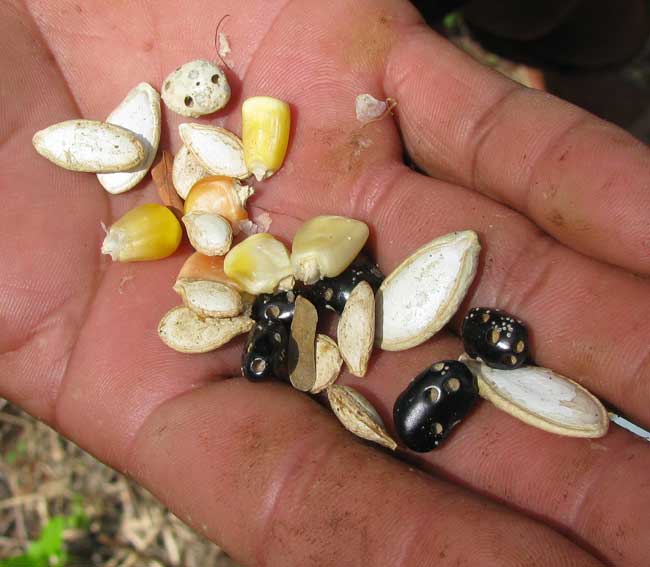Excerpts from Jim Conrad's
Naturalist Newsletter

from the July 25, 2010 Newsletter issued from Hacienda Chichen Resort beside Chichén Itzá Ruins, central Yucatán, MÉXICO; limestone bedrock, elevation ~39m (~128ft), ~N20.676°, ~W88.569°
ORGANIC GARDEN UPDATE
I've learned a lot with the organic garden, but that doesn't mean that things are going well. We still don't have diatomaceous earth, Bacillus thurengiensis or any of the other standard tools used to organically fight insects, or sulfur powder to fight fungi, and so far garlic and habenero pepper hasn't been purchased for making insect-repelling juice to experiment with. The earlier concoction of juice from liquefied garlic and Common Rue seemed to protect against chewing caterpillars but we didn't have enough Rue for further use. Insects are simply having their way with the garden.
Stem borers completely wiped out my cucumbers and squash. I've also learned that, at least during the rainy season, when you sow small seeds of things like parsley, chamomile and thyme, what seeds the ants don't cart off as soon as they're sown germinate into tiny, succulent seedlings that disappear the first day because so many kinds of invertebrates like to eat them.
The good news is that pepper plants, quintessential Mexican species, if you put collars around them to keep cutworms at bay, aren't bothered much by the insects we have here. Currently the pepper plants are loaded with flowers and immature peppers of several kinds. Similarly most tomato plants (also native American) have survived and are producing green tomatoes. Still, I must deworm the plants by hand each day, tossing the worms to where birds can see them and carry them away. Also, during these very rainy days several tomato plants are developing a fungal disease for which we have no sulfur to control it, so the entire tomato crop may be lost to that.
You might be interested in reviewing a page from Colorado State University describing various insecticides permitted in organic gardening at http://www.colostate.edu/Dept/CoopExt/4dmg/VegFruit/organic.htm.
Organically listed fungicides are discussed at http://www.planetnatural.com/site/xdpy/kb/organic-fungicides.html.
Many problems could be solved by planting seeds of crops developed locally. The Maya have their own special varieties of tomatoes, peppers, squash, corn, beans, onions and even watermelons, which grow rampantly with little care. I've asked everyone I know for locally produced seeds but after all these months I till have none.
A local fellow has been hired to organically plant a traditional cornfield next to my garden. You can see his handful of locally produced seeds, including two kinds of large, round, hard-rinded squash (between a pumpkin and a gourd), corn and black beans at the top of this page. In 2007 in Querétaro we had a similar picture, shown at www.backyardnature.net/q/corn4.jpg.
It's beautiful how the wisdom of this combination of seed types has spread through all of Mesoamerica, and a shame that most cornfields seen here nowadays just contain corn.
The beans of the fellow putting out the cornfield, or milpa, next to my garden are so worm-eaten that I wonder if any will germinate. Still, if things continue as they are, I suspect that his traditional cornfield will produce plenty but my "gringo organic method" without the usual organic-gardening tools won't.